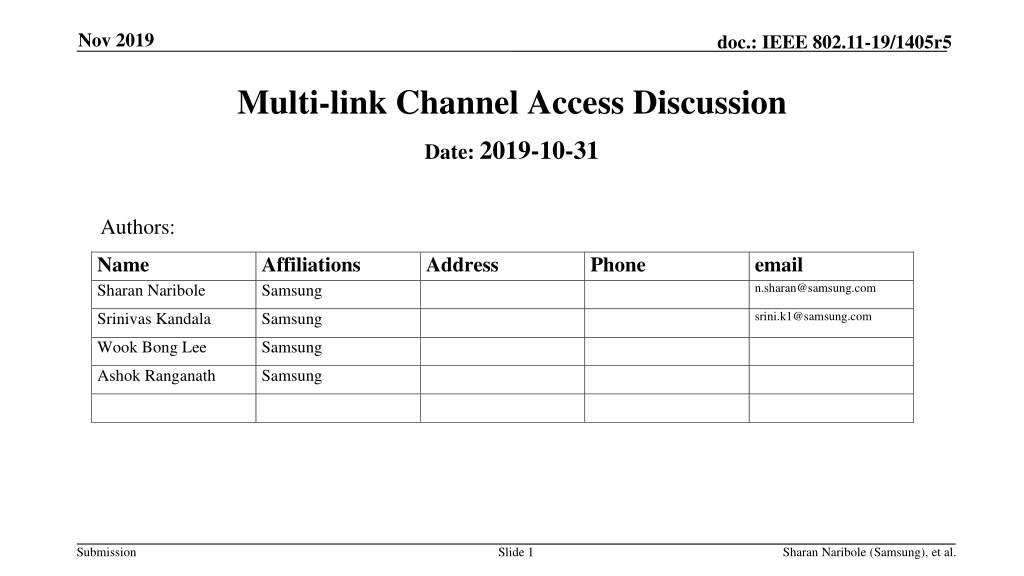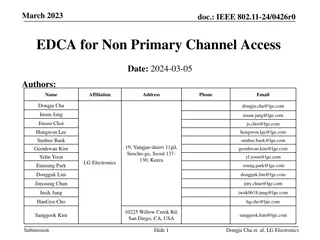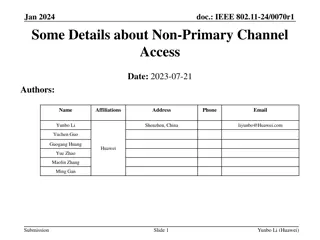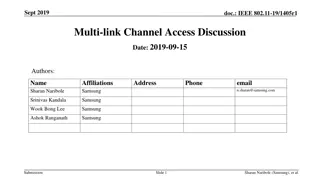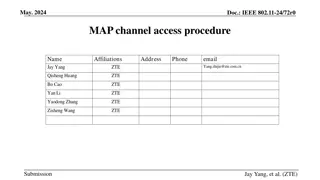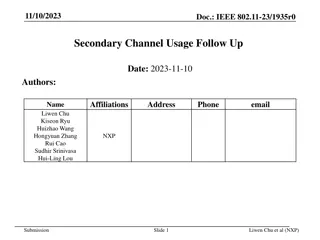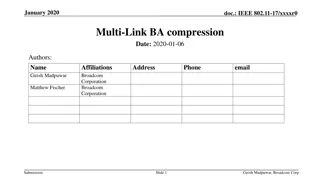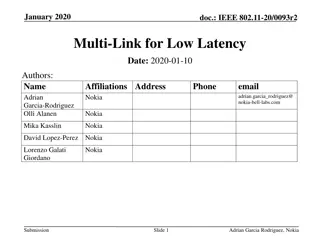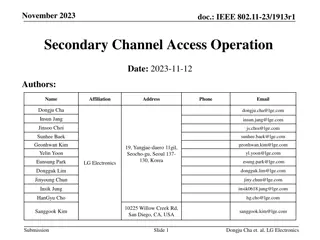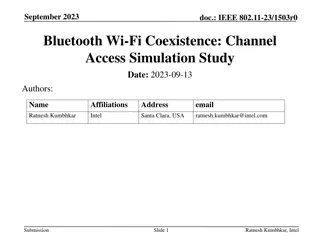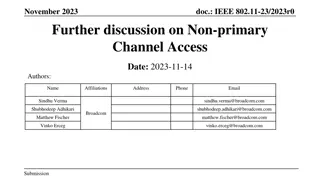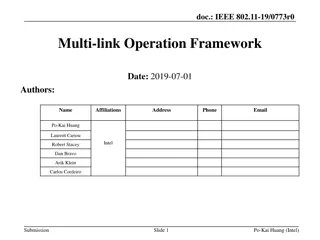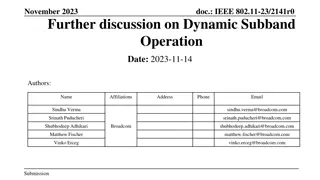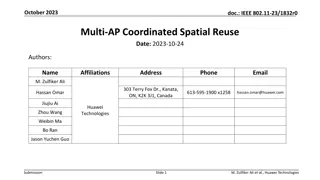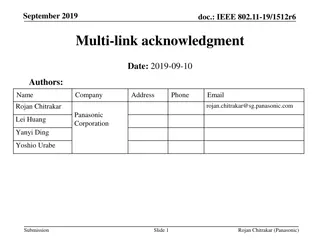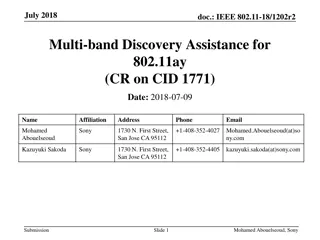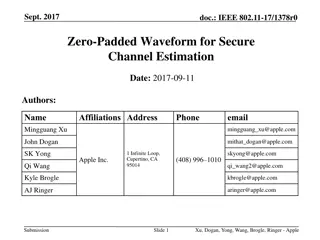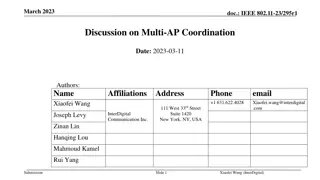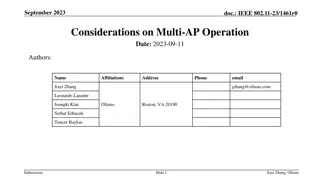IEEE 802.11-19/1405r5 Multi-Link Channel Access Discussion
The document discusses multi-link channel access in IEEE 802.11-19/1405r5, focusing on aspects like transmission of frames over multiple links, minimizing negotiation overhead for fast link switching, and per-link backoff procedures. It covers asynchronous and synchronous operations, STR constraints, collision scenarios, and the STR capability of non-AP STAs in multi-link setups.
Download Presentation

Please find below an Image/Link to download the presentation.
The content on the website is provided AS IS for your information and personal use only. It may not be sold, licensed, or shared on other websites without obtaining consent from the author. Download presentation by click this link. If you encounter any issues during the download, it is possible that the publisher has removed the file from their server.
E N D
Presentation Transcript
Nov 2019 doc.: IEEE 802.11-19/1405r5 Multi-link Channel Access Discussion Date:2019-10-31 Authors: Name Sharan Naribole Affiliations Samsung Address Phone email n.sharan@samsung.com srini.k1@samsung.com Srinivas Kandala Samsung Wook Bong Lee Samsung Ashok Ranganath Samsung Submission Slide 1 Sharan Naribole (Samsung), et al.
Nov 2019 doc.: IEEE 802.11-19/1405r5 Introduction Multi-link Operation o Candidate feature being discussed in TGbe group o Several aspects Transmission of frames of a TID over multiple links [1] Minimizing negotiation overhead for fast link switching [2] Multi-link Channel Access o Several discussions on multi-link channel access, asynchronous and synchronous operations o A few contributions have considered multi-link operation with single primary [3,4] Similar to 80 + 80 operation in which all devices perform backoff only one link In this presentation, we focus on multi-link channel access with per-link backoff Submission Slide 2 Sharan Naribole (Samsung), et al.
Nov 2019 doc.: IEEE 802.11-19/1405r5 Asynchronous Operation Asynchronous multi-link channel access o Per-link backoff procedure with no synchronization of multi-link transmissions o Single link STAs and legacy STAs can operate on any link o Simultaneous transmit and receive operation (STR) o Shall be the default multi-link access mode STR Constraint [3,5,6,7] o STA may not be capable due to in-device power leakage from insufficient frequency separation o Example: Link A operating in lower 5 GHz and link B operating in upper 5 GHz Submission Slide 3 Sharan Naribole (Samsung), et al.
Nov 2019 doc.: IEEE 802.11-19/1405r5 STR Constraint at AP AP (Not STR capable) STA 1: Multi-link STA STA 2: Single link STA STR collision example o AP is not capable of STR and hence fails to receive STA 2 s transmission o Several collision scenarios present in multi-link BSS with AP not capable of STR o Challenging to perform complete synchronized operation due to legacy devices, single link STAs, OBSS traffic, etc. Therefore, AP that establishes multi-link BSS for EHT multi-link operation shall have STR capability for all link pairs Submission Slide 4 Sharan Naribole (Samsung), et al.
Nov 2019 doc.: IEEE 802.11-19/1405r5 Non-AP STA s STR Capability Multi-link STAs indicate STR capability to AP o Dynamic indication by ML STA based on operating links In this context, classification of non-AP STAs on a link pair o STR STA ML STA operating on both links and capable of STR on that link pair o Non-STR STA ML STA operating on both links and not capable of STR on that link pair o Single link STA STA operating only on one of the links of the link pair Submission Slide 5 Sharan Naribole (Samsung), et al.
Nov 2019 doc.: IEEE 802.11-19/1405r5 Collision Scenarios for Non-STR STAs Independent medium access with no channel status sharing between the links Timelines shown for non-STR STA (STA 1) Scenario 1 o STA 1 transmits while receiving frame destined to it o AP transmits to STA 1 while receiving from STA 1 o STA 1 fails to receive Scenario 2 o STA 1 does not detect STA 2 s transmission by ED check o Collision at AP STA 1: Non-STR STA, STA 2: single link STA Objective: To improve multi-link utilization of non-STR STAs with the constraint of preventing STR collisions Submission Slide 6 Sharan Naribole (Samsung), et al.
Nov 2019 doc.: IEEE 802.11-19/1405r5 Opportunistic Backoff Countdown Resume at non-STR STA For certain conditions, non-STR STA resumes countdown on link B during busy state on link A Similar to 802.11ax SRP-based spatial reuse backoff procedure Inter-BSS PPDU (e.g. BSS Color) o Backoff countdown can be resumed as frame not for non-STR STA Intra-BSS Uplink PPDU o Backoff countdown can be resumed, similar to above o UL/DL bit in HE-SIG-A for HE SU PPDU/ER SU PPDU o UL MU identified by HE TB PPDU Intra-BSS Downlink PPDU o Backoff countdown can be resumed if PPDU identified to be not destined to itself o STA ID in HE-SIG-B for HE MU PPDU or unable to decode HE-SIG-B of HE MU PPDU o No STA ID info in PHY preamble for SU PPDU and MAC header decoding can take long o Proposal: STA ID info in EHT PHY preamble for SU PPDU Submission Slide 7 Sharan Naribole (Samsung), et al.
Nov 2019 doc.: IEEE 802.11-19/1405r5 Non-STR STA indication in Uplink STA 1 (Non-STR STA) Preventing AP from transmitting to any non-STR STA while receiving any intra-BSS PPDU may be too conservative Trigger-based PPDU o AP knows which non-STR STAs are transmitting (except random RUs) SU PPDU o STA ID info in EHT PHY preamble o If STA ID info indicates a non-STR STA, AP can still transmit to other non-STR STAs Submission Slide 8 Sharan Naribole (Samsung), et al.
Nov 2019 doc.: IEEE 802.11-19/1405r5 Multi-link Busy State Feedback STA 1: Non-STR STA, STA 2: single link STA STA 1 Non-STR STA misses PHY preamble on link B during its TX on link A Performs ED check on link B after its link A TXOP and cause collision at AP on link B AP knows ML STA s non-STR constraint and AP s current reception of intra-BSS PPDU Proposal: When non-STR STA completes transmission in link A, if AP is currently receiving intra-BSS PPDU on link B or if AP is transmitting on link B, then AP indicates Busy Status in feedback (ACK in figure) to non-STR STA on link A. Accordingly, non-STR STA suspends backoff procedure until the occurrence of an intra-BSS PPDU reception or aPPDUMaxTime countdown expiry Submission Slide 9 Sharan Naribole (Samsung), et al.
Nov 2019 doc.: IEEE 802.11-19/1405r5 Multi-link Channel Access with Proposed Enhancements Proposed methods can be applied by non-STR STAs and AP Snapshot from a multi-link BSS timeline from non-STR STA s perspective Submission Slide 10 Sharan Naribole (Samsung), et al.
Nov 2019 doc.: IEEE 802.11-19/1405r5 Multi-link Channel Access Rules Rules for STR STAs and AP o Follows EDCA channel access protocol on each link o Additionally, if AP, o shall not transmit to a non-STR STA from which it is receiving frame(s) o shall include busy status in feedback to non-STR STA if transmitting or receiving an intra-BSS PPDU on other link Rules for Non-STR STAs o EDCA channel access protocol on each link with following restrictions Suspend backoff countdown when RX on link A and vice versa Perform Opportunistic Backoff Countdown Recommencement Suspend backoff countdown on link A when TX on link B and vice versa Suspend backoff countdown on link B when AP indicates Busy State of link B o We can further consider multi-link TXOP aggregation [8] Submission Slide 11 Sharan Naribole (Samsung), et al.
Nov 2019 doc.: IEEE 802.11-19/1405r5 Summary Multi-link BSS AP shall have simultaneous transmit and receive (STR) capability Non-AP STAs may or may not have STR capability and indicate this info to AP Problem scenarios for asynchronous multi-link operation with non-STR STAs Proposed mechanisms to improve the medium utilization by non-STR STAs o Opportunistic backoff countdown recommencement o STA ID indication in EHT PHY preamble o Secondary link busy status in feedback to non-STR STA Submission Slide 12 Sharan Naribole (Samsung), et al.
Nov 2019 doc.: IEEE 802.11-19/1405r5 Straw Poll #1 Do you support 802.11be have a mode of multi-link operation for multi-link logical entities* which can t support simultaneous transmit and receive capability? - Both non-AP STAs and APs multi-link logical entities* included - Signaling of this capability is TBD *exact name can be changed Submission Slide 13 Sharan Naribole (Samsung), et al.
Nov 2019 doc.: IEEE 802.11-19/1405r5 Straw Poll #2 Do you agree that in 802.11be, multi-link logical entities* that can t support simultaneous transmit and receive capability require multi-link channel access mechanisms different from multi-link logical entities* with simultaneous transmit and receive capability? * exact name can be changed Submission Slide 14 Sharan Naribole (Samsung), et al.
Nov 2019 doc.: IEEE 802.11-19/1405r5 References [1] 11-19/979, EHT Multi-link Operation Follow-up [2] 11-19/822, Extremely Efficient Multi-band Operation [3] 11-19/1116, Channel Access in multi-band operation [4] 11-19/1144, Channel Access for Multi-link Operation [5] 11-19/766, Enhanced Multi-band/Multi-channel Operation [6] 11-19/1548, Channel Access Design for Synchronized Multi-Links [7] 11-19/1550, Simultaneous Tx/Rx Capability indication for multi-link operation [8] 11-19/1505, Multi-link Aggregation Considerations Submission Slide 15 Sharan Naribole (Samsung), et al.
Nov 2019 doc.: IEEE 802.11-19/1405r5 Appendix Submission Slide 16 Sharan Naribole (Samsung), et al.
Nov 2019 doc.: IEEE 802.11-19/1405r5 Collision Prevention with Non-STR STAs Conservative approach at non-STR STA o Suspend backoff countdown on link A when RX on link B o Suspend backoff countdown on link A when TX on link B Conservative approach at AP o Shall not transmit to non-STR STA when receiving an intra-BSS PPDU Prevents STR collisions at non-STR STAs without any additional information Despite TXOP aggregation, there can be significant multi-link under-utilization STA 1: Non-STR STA, STA 2: single link STA Submission Slide 17 Sharan Naribole (Samsung), et al.
